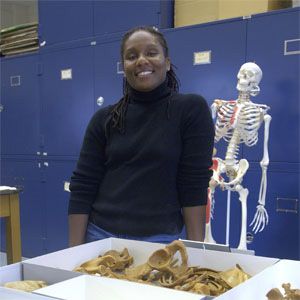

Rachel Watkins , an assistant professor in the Department of Anthropology at American University in Washington, D.C., is a biocultural anthropologist, which means she studies how people’s physiological conditions–their health and disease states–reflect the social, cultural, economic, and political environment in which they lived.
“Biocultural anthropologists,” says Watkins, “are physical anthropologists that are committed to determining the facts of peoples’ lives by integrating biological and cultural data .” Her research quantifies the physiological affect life has on the human body, namely the physical effects of poverty and other manifestations of inequality.
Watkins is currently on a 1-year research sabbatical at Howard University during which she is studying urban African-American populations in the Southeast and East Coast. She is, she says, continuing work pioneered by other African-American physical anthropologists such as William Montague Cobb and Caroline Bond Day. “Cobb did pioneering work on the health consequences of poverty and inequality, but hasn’t been cited or recognized by current scholars, despite the fact that he had over 1100 publications,” Watkins explains. “Day’s work contested the ideas of biological determinism and racial differences. Being a black woman, I certainly feel that I’m standing on her shoulders.”
Although Day and Cobb have both influenced Watkins’s work, Cobb laid the physical foundation by establishing the collection of skeletons Watkins is currently studying. The collection, which contains more than 600 skeletons of African Americans who lived and died in Washington, D.C., between 1930 and 1969, is housed at Howard University. Cobb assembled much of the collection before the mid-1950s, when the corpses of the poor often ended up as state property. “When someone died, and the families were unable to pay for burial, their bodies became wards of the state,” Watkins says. “They weren’t buried, but distributed to different medical schools in the city to be used as cadavers in anatomy classes. Not every individual in the collection was acquired through those means, but most that came into the collection before the mid-50s were.” Since many of the people whose skeletons ended up in Cobb’s collection lived through the Great Depression, Watkins wants to understand how this time of economic upheaval affected them.
Watkins starts her research day by pulling the skeletons she plans to examine out of storage cabinets. After laying them out on an examination table, she examines each bone for signs of excessive physical demand, fractures, or nutritional deficiencies. Because signs of infection leave minute traces on bone, she uses magnification lenses to search for them. When she wants to determine age, sex, and stature, she compares standard measurements of bone casts at different ages and data from anthropological manuals to her measurements.
In addition to her bone work, Watkins travels to the Schomburg Center for Research in Black Culture in New York City to do library research that will help her fill in the pieces of the puzzle. “The Schomberg Center,” says Watkins, “is probably the largest archive involving African-American history, including art and literature in the world. To interpret health and disease patterns in this population, I’ll have to find documents that deal with African-American life in cities during the Depression.”
(Read more at Sciencemag)
